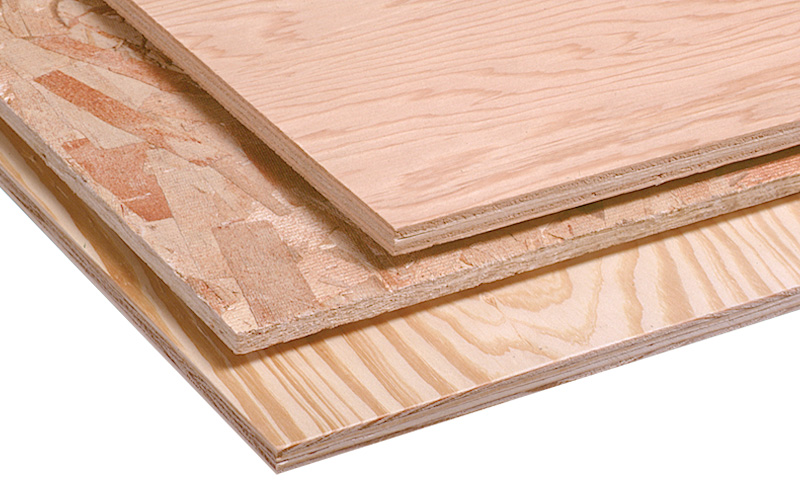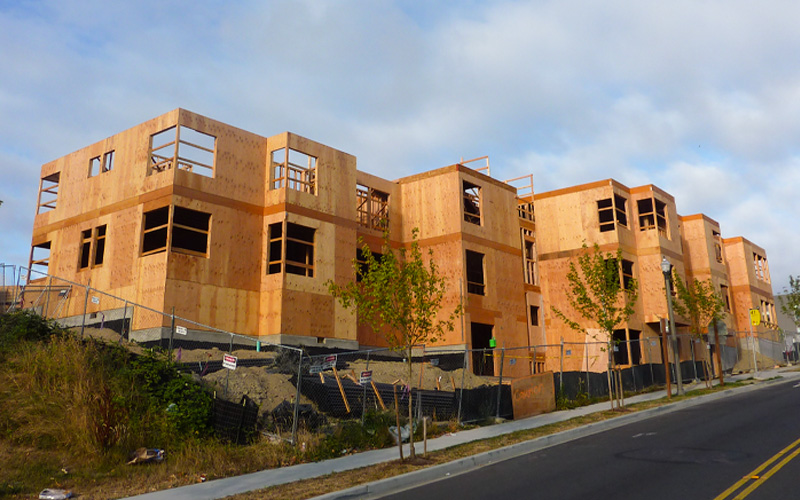Structural I, also referred to as “STRUC I,” may be OSB or plywood and is, essentially, a subcategory of APA Rated Sheathing. Panels designated Structural I must meet all of the manufacturing and performance standards of Rated Sheathing, as well as certain additional requirements. These additional requirements relate to increased racking performance related to shear wall and diaphragm values and increased cross panel strength and stiffness properties which are important when panels are applied with the strength axis parallel to the supports, as is typical in panelized roofs.
The advantages of Structural I Rated Sheathing over standard Rated Sheathing panels of the same Performance Category are realized in certain specialized engineered construction applications such as engineered shear walls and engineered horizontal diaphragms. Beyond these specialized applications, Structural I offers no additional benefit for traditional construction applications.
Sourcing Structural I Sheathing
First and foremost, is it necessary to specify Structural I? For most applications that don’t necessitate maximizing shear walls, diaphragms or similar engineered structural components, regular Rated Sheathing is sufficient. Structural I lends no additional benefits for traditional construction applications. Structural I Rated Sheathing panels carry the same Span Ratings as Rated Sheathing panels of the same thickness, e.g., 15/32 Performance Category (PERF CAT) Structural I and 15/32 PERF CAT Rated Sheathing are both Span Rated at 32/16 and deliver the same capacity for most applications.
Regional availability also comes into play. Before specifying Structural I, check with your supplier to ensure it is available in your region. Although common in western states, Structural I may be challenging to source in other regions. If availability of Structural I in your area is problematic, use of thicker Rated Sheathing usually provides an equivalent load capacity (although at thicknesses over 19/32 PERF CAT, the distinction is probably moot). In many applications, a substitution of Rated Sheathing that is 1/8 PERF CAT thicker than the specified Structural I will result in comparable performance.

Avoiding Confusion
Structural I is unrelated to the bond classifications, also known as exposure durability classifications, Exposure 1 and Exterior. These two designations signify only the moisture resistance of the panel adhesive bond appropriate to its intended end use. Structural I Rated Sheathing may carry either an Exterior or an Exposure 1 designation.
Bond classification relates to moisture resistance of the glue bond, and thus to the structural integrity of the panel. Exterior panels have bonds capable of withstanding repeated wetting and redrying or long-term exposure to weather or other conditions of similar severity, provided they are properly finished and maintained. Examples of panel applications with Exterior bond classification are signs, siding and closed soffits. Exposure 1 panels are suitable for uses not involving long-term exposure to the weather but are intended to resist the effects of moisture due to construction delays, or other condition of similar severity.
Also, Structural I is not to be confused with the more general terms “structural-use panels” or “structural panels,” which refer to all of the grades of plywood and OSB manufactured under U.S. Voluntary Product Standards PS 1 and PS 2.
And although it’s a small distinction, note that Structural I uses the Roman numeral for one, as opposed to Exposure 1’s use of the more familiar Arabic numeral 1.
Writing Panel Specs
Panels are specified in the following order: PERF CAT, APA trademark, Panel Grade, Span Rating, Exposure Durability Classification, and additional information as needed (optional). For example: 15/32 PERF CAT APA Rated Sheathing 32/16 Exposure 1. The PERF CAT refers to the panel thickness, or Performance Category.
More Details on Structural I
Tabulated values for specialized applications where Structural I is of benefit are provided in APA’s Engineered Wood Construction Guide. Design capacities of Structural I and Rated Sheathing panels are provided in APA’s Panel Design Specification.
For more information on engineering diaphragms and shear walls, consult the APA Design/Construction Guide: Diaphragms and Shear Walls, contact your local APA Engineered Wood Specialist or watch APA’s free on-demand webinar, Shear Exhilaration: Wood Shear Wall and Diaphragm Design per the 2021 IBC, for a top-to-bottom overview of lateral design for wood-framed structures with a focus on shear walls.
Explore additional free design resources at www.apawood.org/design-build.






